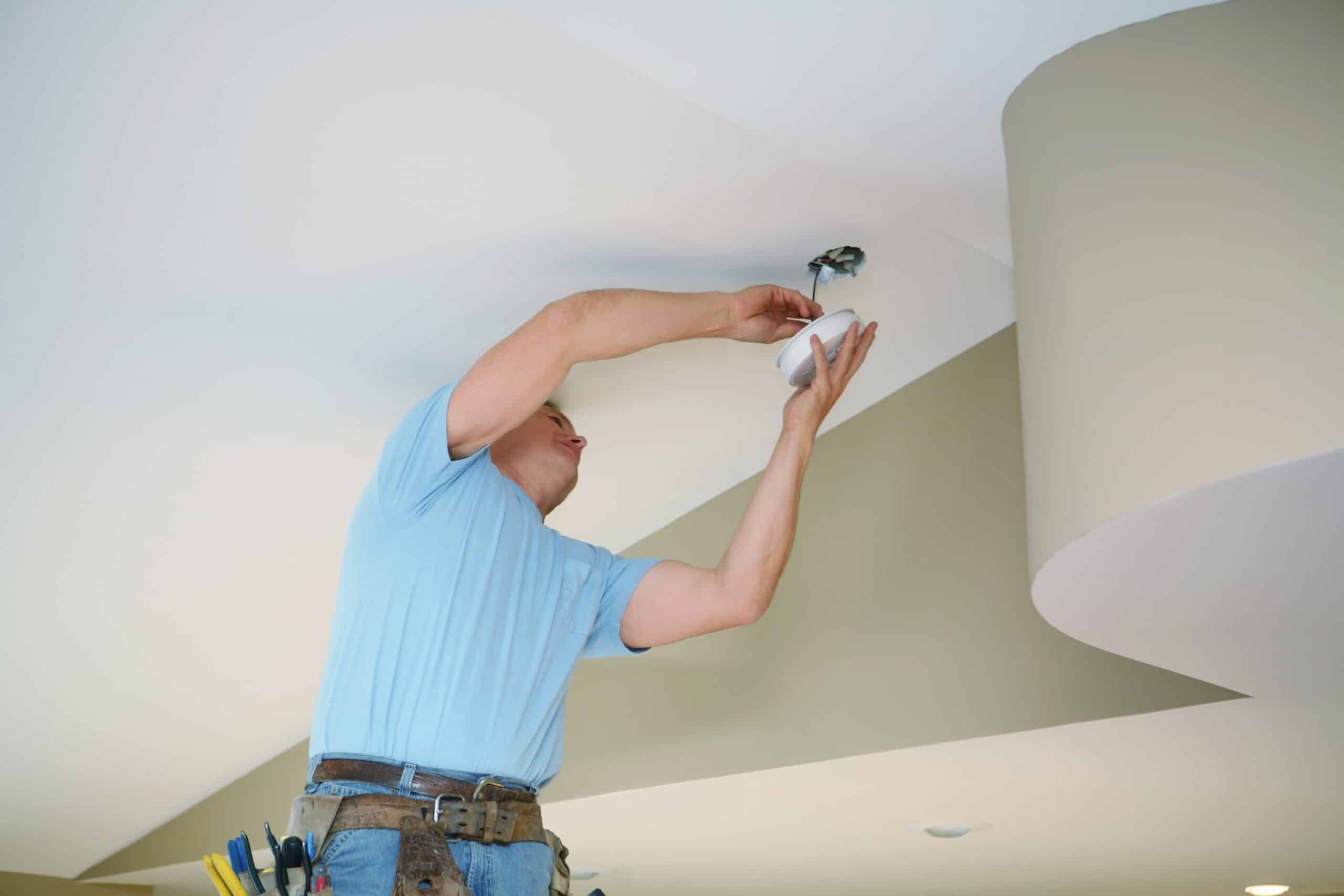How to Test Smoke Detectors

According to the CDC, thousands of patients visit the emergency room every year for carbon monoxide poisoning. In rare cases, carbon monoxide can cause death, and approximately 393 people die every year. Fatalities can be cut by more than half in homes with a functional sensor. Maintenance of the device is, therefore, crucial for your safety. In this article, we outline how to test and maintain the smoke detectors in your home.
How Smoke Detectors Work
Before you can test smoke detectors, it is essential to understand how they work. Such devices aim to detect fires in the shortest time possible. The sensor should also survive the flames long enough to send alarm signals that the building’s occupants will notice.
Electricians may categorize the devices according to their power source. Some detectors are battery-powered. Battery-powered devices are inexpensive and easy to install. But the sensor can stop working during a fire, or the battery may fail at unexpected times.
AC-powered detectors draw their energy from your home’s electrical system. Their primary advantage is that the device may continue working when there is a fire. Most sensors will have a backup in case of an emergency.
But AC-powered fire detectors are intricate devices that require the skills of a professional electrician. Brennan Electric electricians in Seattle can assist you with testing your safety systems. The location of the fire sensing device during installation can impact its efficiency.
Ionization and Photoelectric Smoke Detectors
According to the NFPA (National Fire Protection Association), there are several technologies for sensing smoke and carbon monoxide. The most common are photoelectric and ionization fire detectors. Both systems are effective. But that depends on the type of fire and other physical factors.
Ionization sensors employ minute quantities of radioactive compounds in a chamber consisting of two electrodes. When the device is working, the current is continuously flowing across the plates. But as smoke enters the chamber, it interrupts the flow of current, triggering the alarm.
On the other hand, a photoelectric detector utilizes optical technologies such as infrared or ultraviolet light. Light is cast across the sensor’s chamber at an angle. As smoke particles rise, they scatter the light away from the sensing components. When smoke blocks light shining on the sensor, the device triggers the alarm.
Ionization fire detectors are more effective at detecting fires that build up quickly. But they are more vulnerable to triggering false alarms than photoelectric systems. For all types of fires, they take longer to respond than optical devices.
Photoelectric devices perform better in smoldering fires. Those are fires that take a long time to build up and have copious amounts of smoke. An optical smoke detector is also considered to be the most efficient technology for detecting all types of fires. But they are more expensive than their ionization counterparts.
Between photoelectric and ionization devices, which one should you install? Both have merits and demerits when it comes to fire detection. NFPA recommends configuring a safety system that utilizes both ionization and photoelectric technologies. It is hard to predict the kind of fire that may break out in the building. Therefore, using both systems is the best way to optimize safety in your home.
It is worth noting that the capabilities of the fire detection device can vary depending on the model and brand. The fire safety system must incorporate carbon monoxide sensors to optimize your home safety. During testing and maintenance, ensure that you assess the performance of both CO2 and CO systems.
Testing Your Home’s CO Detectors
Virtually all fire and smoke detection systems have similar features include a blinking light and a test button. When you push the test button, it should blink and produce sounds. While devices may vary, the basics design of these test features is more or less the same.
Brennan Electric‘s electricians in Seattle recommend testing the fire sensing devices at least once a month. You can assess the device by pushing the test button for a few seconds. If there is no sound, the sensor could either be faulty or may need a battery change.
Some models of smoke detectors will make a chirping noise to indicate when the battery is getting low. You may want to change the batteries to confirm if your device is working. Make a point of replacing the batteries twice a year to ensure the smoke detectors are always on. If there is still no response after changing batteries, you may want to have the sensor checked by an electrician.
Match Test and Maintenance
On average, smoke detectors have a lifespan of ten years. During that time, the internal chamber will experience dust, debris, and smoke buildup. Obstructions within the sensor’s components can impact the sensor’s efficiency in detecting fire.
The match test is one way to test if the sensor can still effectively detect fire and smoke. Strike three wooden matches together, and blow it out a foot below the fire detector. The detector may take some time before responding. If after a few minutes it does not respond, change the batteries and try the test again.
As you perform the test every month, you can take the opportunity to clear the area of dust and debris. Chemical solutions can get into the detector and may compromise its function. If the devices in your home are older than ten years, you may want to get a replacement.
Getting a Replacement for the Fire Sensor
The best course of action when you have a faulty device is to seek a replacement. Not only is a new model more efficient, but also recent technologies come with more features. Some have a hush button that can reset the device after sounding the alarm. That way, you can avoid the nuisance of a continuous ringing from a false trigger.
Homeowners should have a smoke detector installed in all bedrooms and on each level of the building. Large homes will need more alarms than smaller ones. If you live in a large house, you may want to check whether it is a connected or an interconnected model.
An interconnected system will sound the alarm across all the devices in the house, rather than just one device. That way, occupants can be aware of the fire regardless of their location on the premises.
You could choose to enhance the functionality of the interconnected devices with a smart home system. Automated systems can send a notification to your mobile phone to alert you of the alarm. You can also get images of your home’s interior even when you are away from home.
The features will depend on the brand and model. It is worth noting that smoke detectors are not always compatible with the Automated home system. So it is wise to double-check the configurations of the device before getting a replacement. Consider consulting a certified electrician to wire and configure your smoke and fire detector.
For your peace of mind, you can consult Brennan Electric‘s highly trained and experienced electricians in Seattle. We are proud of the recognition from Angie’s List Super Service Award in 2019. It is a testament to our team’s outstanding service since 1987. Our team’s core values are honesty, integrity, and quality service. Talk to our A+ rated staff to experience our world-class customer service.

